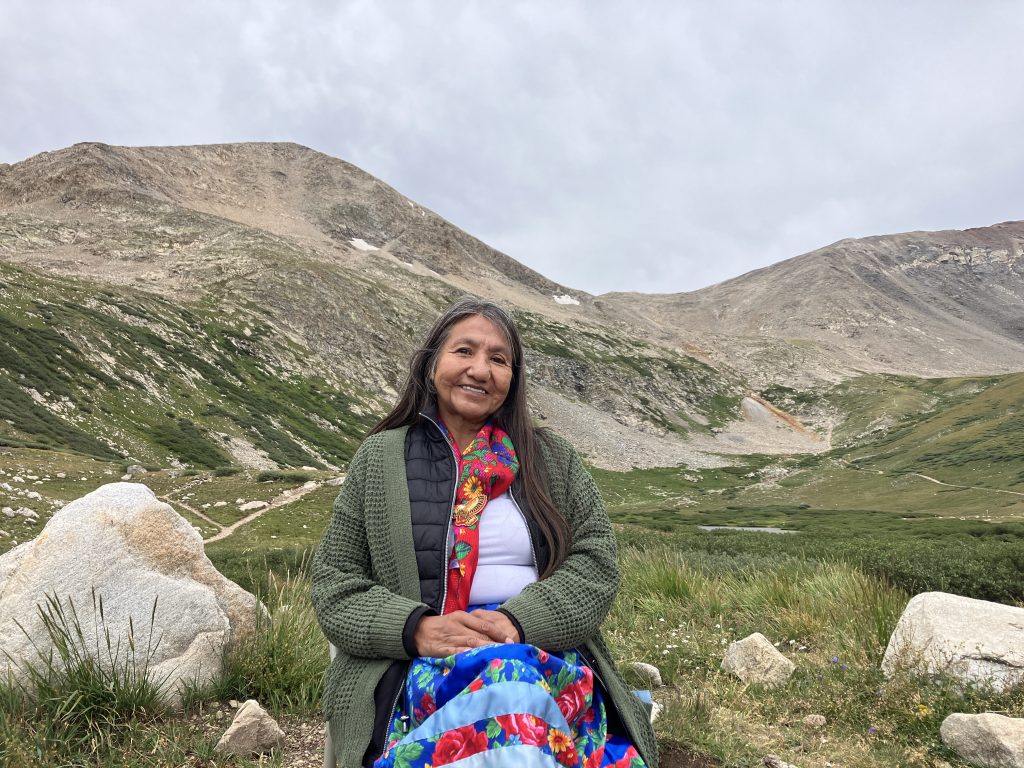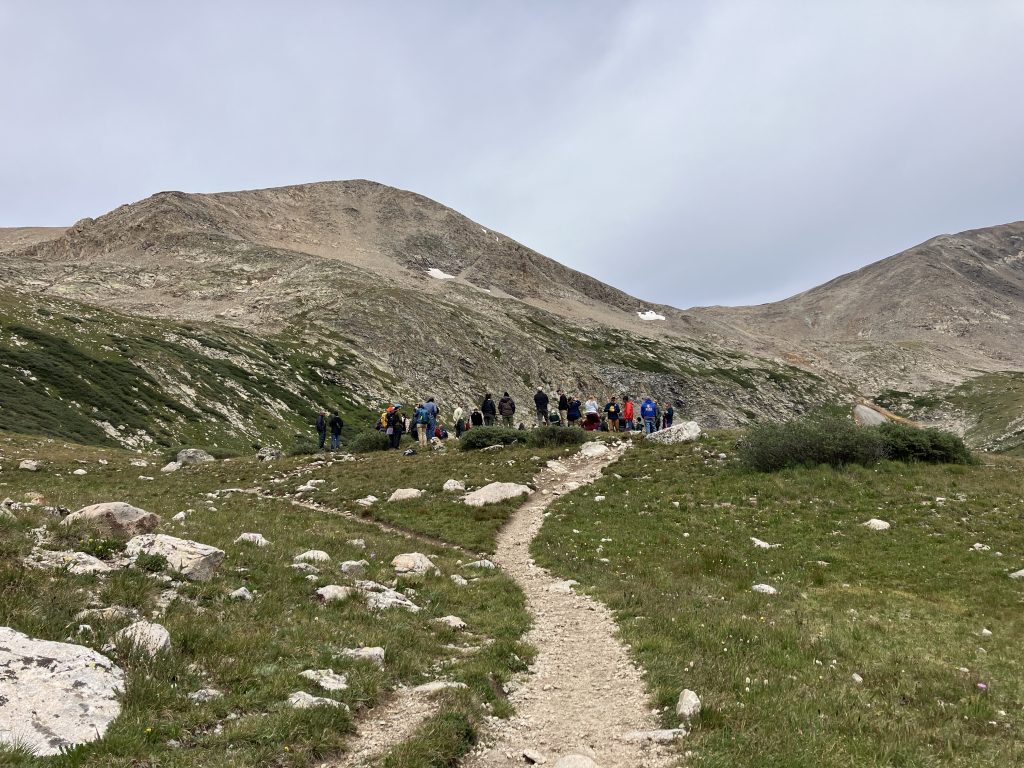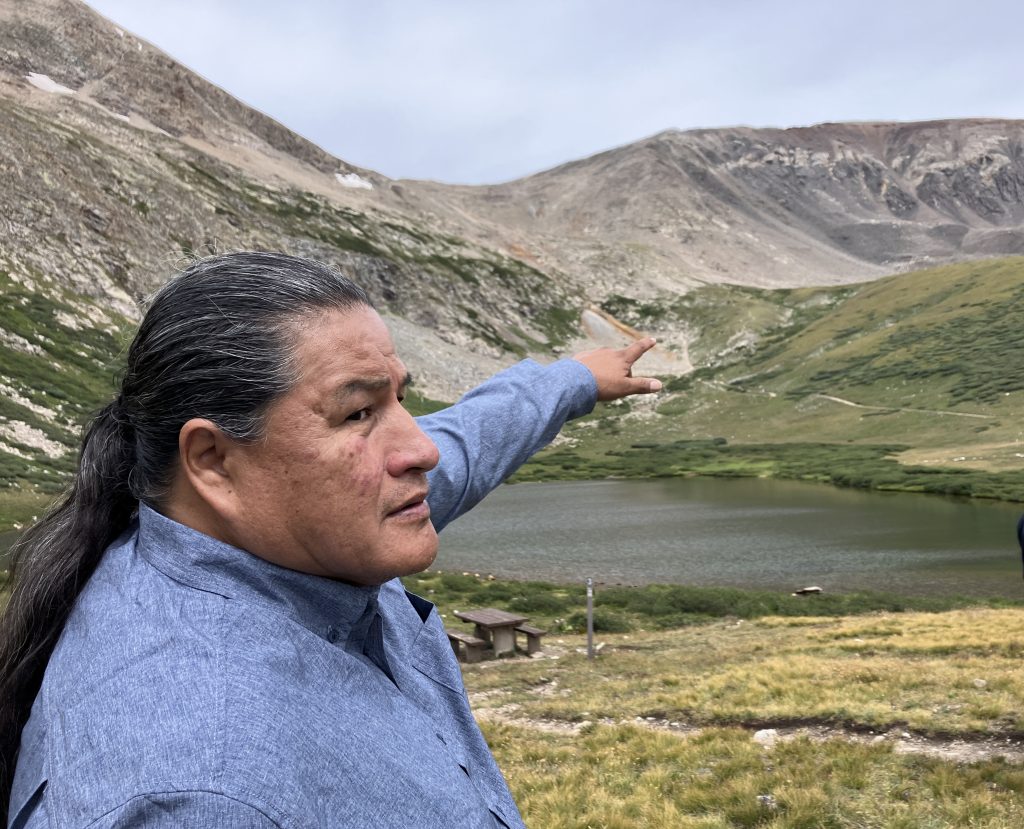 Southern Ute Tribe historic preservation officer Cassandra Atencio said that Colorado’s 14ers should have interpretive signage to educate the public on the Native American tribes indigenous to the mountain region. “The Ute people are still here, we have always been here and we’re trying to stay connected to our land,” Atencio said.
Southern Ute Tribe historic preservation officer Cassandra Atencio said that Colorado’s 14ers should have interpretive signage to educate the public on the Native American tribes indigenous to the mountain region. “The Ute people are still here, we have always been here and we’re trying to stay connected to our land,” Atencio said.
Ryan Spencer/Summit Daily News
As hikers meandered along the trailhead to Mount Democrat on a cool August morning, members from Native American tribes with deep roots in the mountains gathered on a grassy knoll beneath the 14,000-foot peak.
Gathered were members of the Ute Indian Tribe, the Cheyenne and Arapaho Tribes, and the Arapahoe Nation. In song and prayer, the tribal members — often speaking their native languages — paid respect to their ancestors, the Earth and the essential connection that binds humanity together.
“It is important that my footsteps are here too, along with my ancestors’, that we’re here now,” Southern Ute Tribe historic preservation officer Cassandra Atencio said during the Aug. 21 ceremony. “All these languages that you’re hearing today — how long has it been since our ancestors heard their own language? The spirits, they came alive and you could feel them.”
The U.S. Forest Service — after acquiring nearly 300 acres of previously private land leading to the summit of Mount Democrat — had arranged the ceremony to recognize the Native American tribe’s connection to the land.
The land acquisition has been lauded as a boon for public access and conservation. Colorado 14ers Initiative executive director Lloyd Athearn said before the ceremony that the summit of Mount Democrat had been closed to public access on and off over the years, including in 2021 and 2023, due to liability concerns from the private landowner.

Support Local JournalismDonate
The Forest Service’s acquisition of the land in December returns the land to public ownership, protecting access to the summit in perpetuity, Athearn said. It also allows for better management of the trail systems through the fragile Alpine environment, which contains species that are globally rare, like the penland Alpine fen mustard that is found only in Park and Summit counties.
“People come from all over the world to climb these mountains, and people get really blown away when they think ‘Wait, someone owns this? Wait, how do they get to own this?’” Athearn said.
 The members of several Native American tribes gathered alongside U.S. Forest Service personnel and the leaders of conservation groups, on Wednesday, Aug. 21, 2024, at the base of Mount Democrat for a ceremony. The U.S. Forest Service invited tribes to participate in the ceremony after it acquired 300 acres of land leading to the summit of Mount Democrat. Ryan Spencer/Summit Daily News
The members of several Native American tribes gathered alongside U.S. Forest Service personnel and the leaders of conservation groups, on Wednesday, Aug. 21, 2024, at the base of Mount Democrat for a ceremony. The U.S. Forest Service invited tribes to participate in the ceremony after it acquired 300 acres of land leading to the summit of Mount Democrat. Ryan Spencer/Summit Daily News
South Park District Ranger Josh Voorhis looked out over Kite Lake at the Rocky Mountain Range as he described the history of the 14,000-foot peaks.
For thousands of years before European settlers ever arrived in the Americas, Native American tribes lived in and traveled through these mountains, Voorhis said. These tribes used trails — segments of which are still traveled today — to move through the high-mountain terrain between summer and winter hunting grounds.
But during the 1800s, as settlers poured into Colorado in search of gold and silver, tribes were removed from their lands through a combination of violent pressure, coerced treaties and the threat of military force.
“It’s the first time these nations have been invited back since they were removed — forcibly removed — from these lands,” Voorhis said. “I kind of look at it as they have ownership in these lands as well. To me, it’s very important.”
Donovan Taylor, a member of the Northern Cheyenne Tribe, said that the mountains in and around Mount Democrat hold significance to Native American tribes because “we all stemmed from one being.”
The ceremony on the knoll set a precedent as the Native American tribes who participated came together “in one area to substantiate existence,” Taylor said. He said that Colorado’s 14ers and high peaks should be protected so that they can be shared by everyone for generations to come, including Native American youth who he hopes will seek internships and other opportunities in the mountains.
Billie Kreger, a member of the Comanche Nation, said her ancestors traveled routes through the mountains to the Great Plains thousands of years ago, after splitting off from the Shoshone people.
Lloyd Heminokeky, also a member of the Comanche Nation, said that Colorado’s mountains, especially its 14,000-foot peaks, have power — the power to take your breath away and to make your legs weak as you climb, he said.
“They could take a man’s life easily, from being too cold or an accident happening up there. We respect them,” Heminokeky said. “We look to these mountains, not only here but other places, for power because that’s how God put them. The Creator put them that way, and then he put us with it too, to have respect for them.”
 Donovan Taylor, a member of the Northern Cheyenne Tribe, points at the rocky ridge line near Mount Democrat during a ceremony on Aug. 21, 2024. “What can you interpret? What kind of story could you interpret just looking at it?” Taylor asked.
Donovan Taylor, a member of the Northern Cheyenne Tribe, points at the rocky ridge line near Mount Democrat during a ceremony on Aug. 21, 2024. “What can you interpret? What kind of story could you interpret just looking at it?” Taylor asked.
Ryan Spencer/Summit Daily News
Atencio — the historic preservation officer for the Southern Ute Tribe — noted that the Ute people are among the oldest residents of what is now known as Colorado, having inhabited the mountains for millenia.
For centuries before European contact, the Ute people would have camped in these valleys, drank from the same source of water that now supplies the town of Alma below Mount Democrat, and traveled the ancient trails through the mountains that have since become highways, Atencio said.
Because the federal government has a nation-to-nation relationship with Native American tribes, Atencio said it is important for the U.S. Forest Service to consult tribes about the management of public lands — like the Colorado 14ers.
Far too many people who visit these beautiful mountains believe that Native Americans are a thing of the past, Atencio said. But that’s not true.
“History forgot us, tried to forget us and annihilate us,” Atencio said. “But we stood strong just like the elders said. We’re still here after all those things. Now, we have a voice. Now that we have a voice, we have to use it, and we have to say something because a long time ago we didn’t have that voice.”
Atencio said that she believes that Colorado’s 14ers should include interpretive signage so that visitors can learn about the “truthful history” of the Native American tribes who were forced out by miners and the zeal of Manifest Destiny.
She said she hopes that anyone who visits Mount Democrat — or any of Colorado’s high peaks — treats the mountains with the respect they deserve so that these resources can be enjoyed for generations to come.
“Now it’s important to start to work together because we all live here on Mother Earth,” Atencio said. “More and more and more people are coming here, so we really need to get started on how to protect and preserve these areas and keep them as pristine as we possibly can.”
Source link : http://www.bing.com/news/apiclick.aspx?ref=FexRss&aid=&tid=66d551a889c54815ab7462d12ff9826c&url=https%3A%2F%2Fwww.vaildaily.com%2Fnews%2Fnative-american-tribes-pay-respect-to-ancestors-during-ceremony-at-colorado-14er-were-still-here%2F&c=8654631766582687266&mkt=en-us
Author :
Publish date : 2024-08-31 13:00:00
Copyright for syndicated content belongs to the linked Source.
